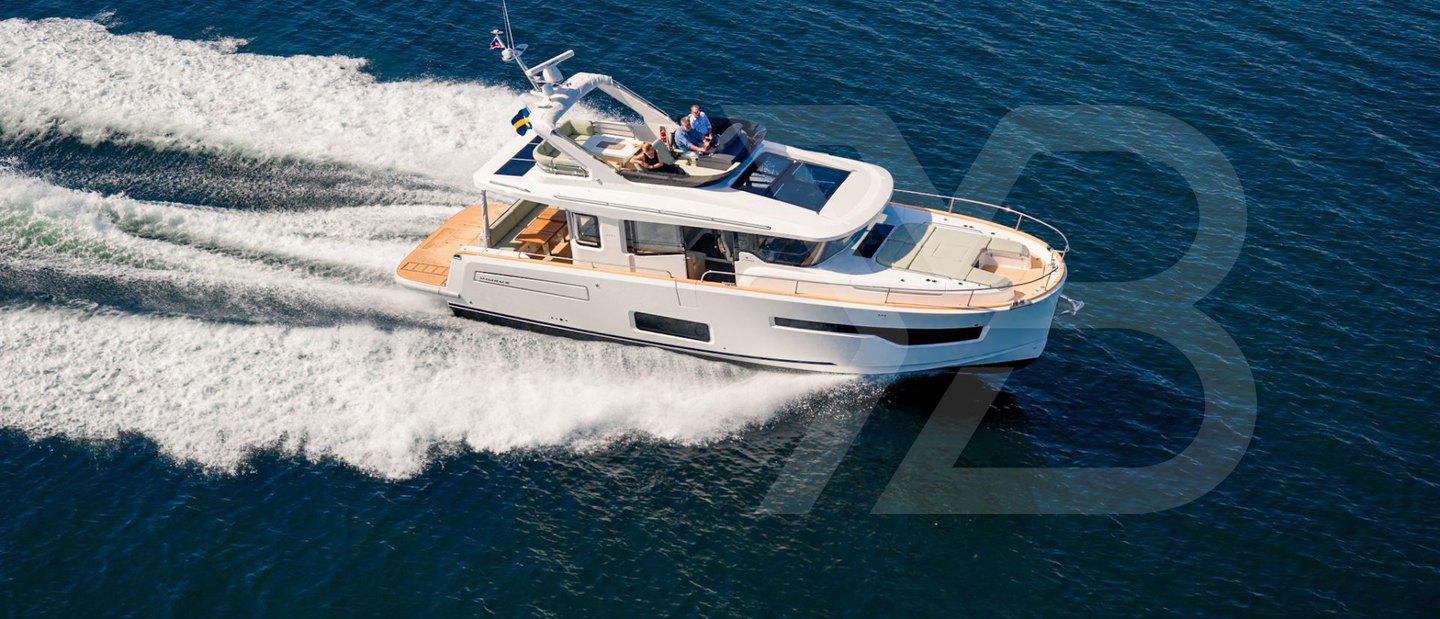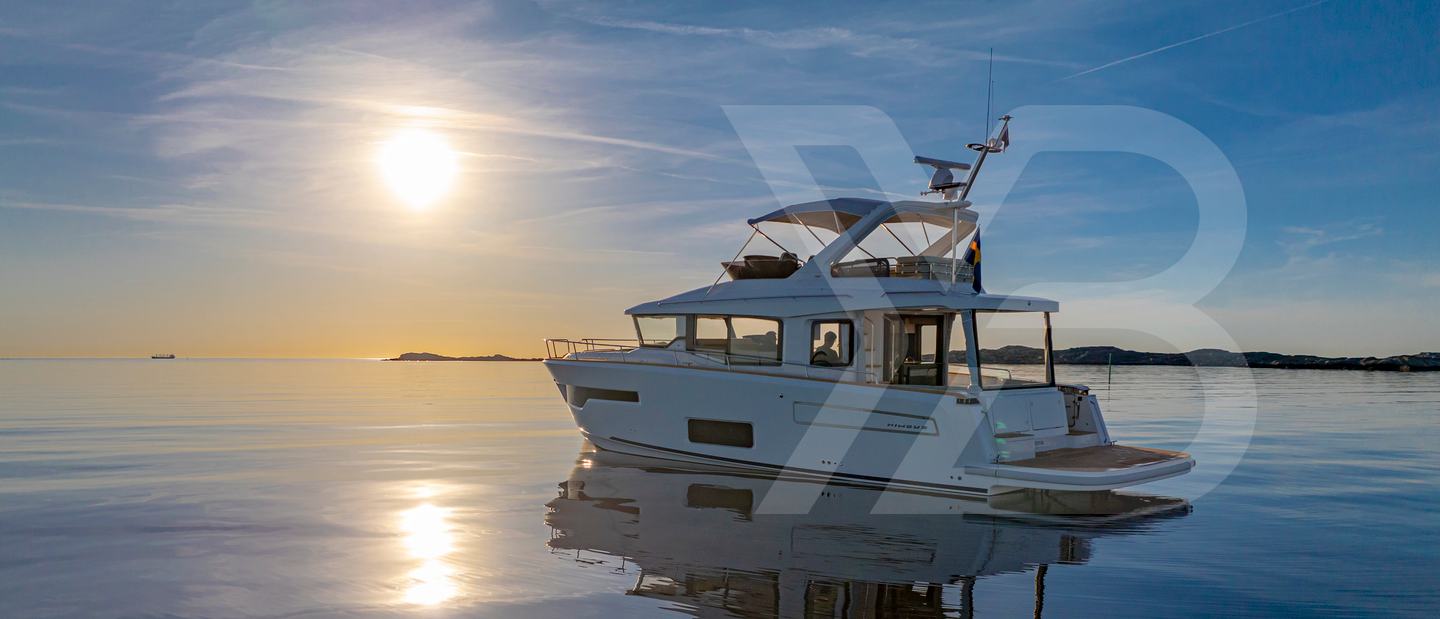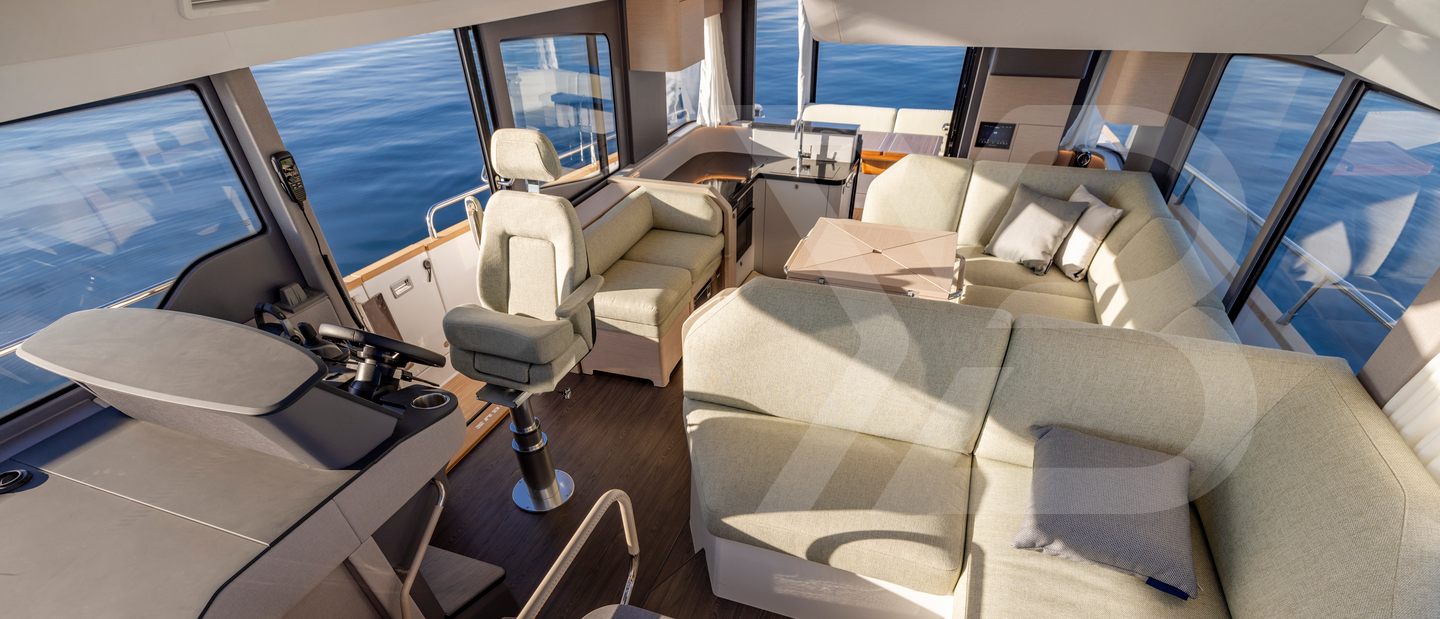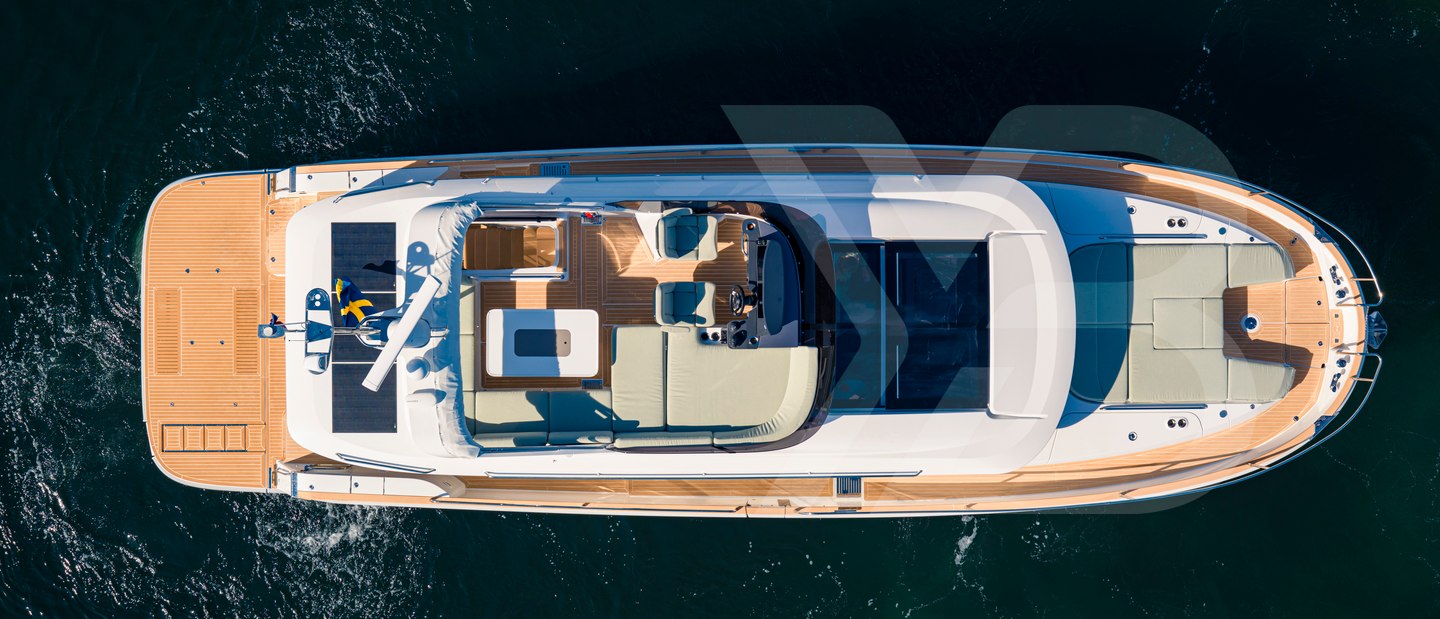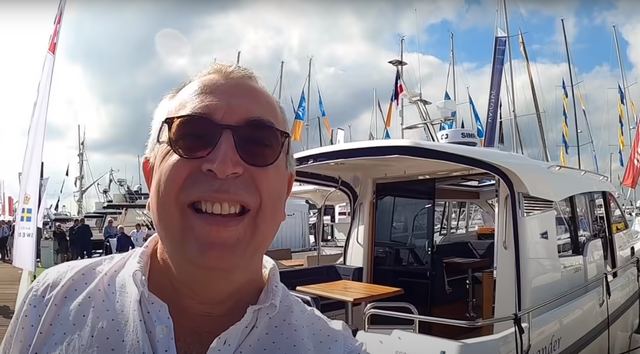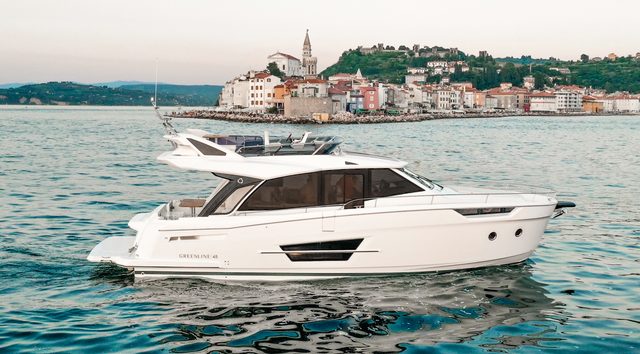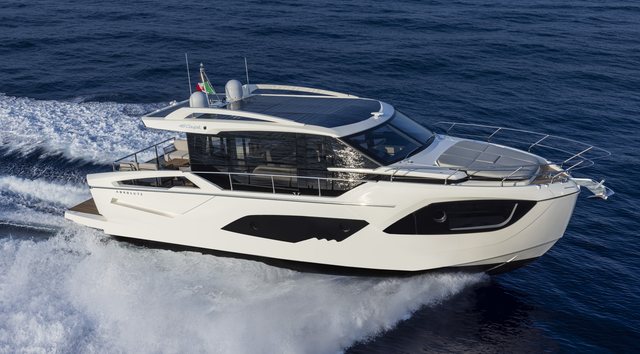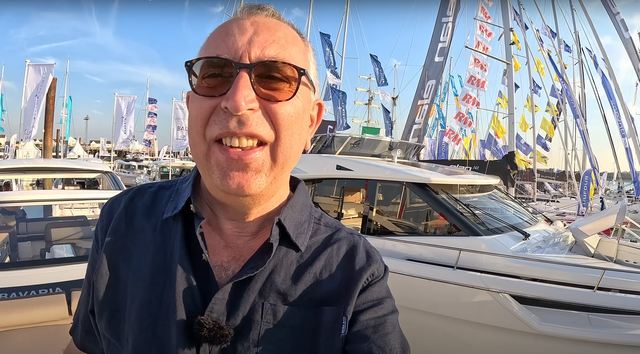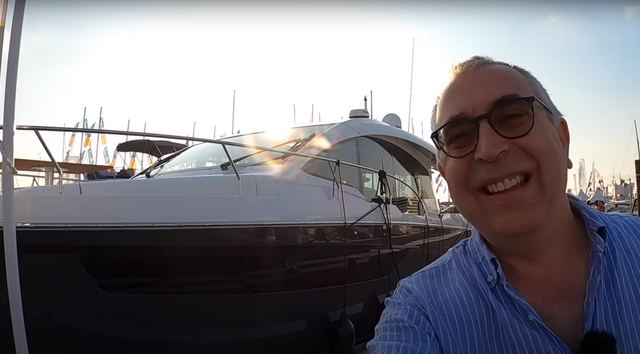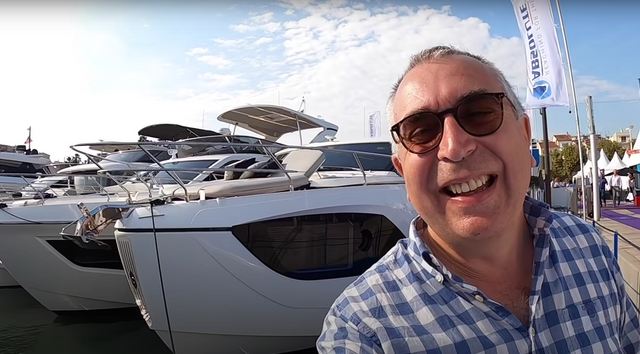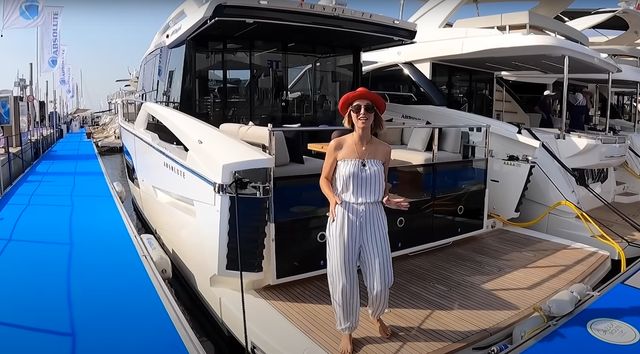Premiered at the Cannes Yachting Festival 2024, the 495 Fly is one of the largest and most cleverly designed cruisers they've ever produced. With Nimbus having focused on the day cruising market for quite a while, its return to building big flybridge cruisers is a significant shift.
Priced at €1,650,000, including VAT, this yacht promises remarkable value for its size. There's a lot to go through, so let's find out what makes the 495 different.
Test & Review Video
Around the Marina
Berthing is where a boat like this really shines. The Nimbus 495 Fly is designed for couples to run themselves, so it needs to be easy to live with when you’re coming into a tight berth with no crew.
First impressions are very good. The joystick control is smooth and precise. One nudge to the side and the whole boat shifts across without any lurching. The IPS system is nicely calibrated, and there’s more than enough thrust to overcome any wind or tide.
The test boat didn’t have a cockpit joystick, but with the lower helm positioned just forward of the starboard side door, it doesn’t really matter. You’ve got direct access to the side deck and gate, so the skipper can pop out, handle lines, or check the stern within a few steps of the wheel.
Corner windows aft give a good visual on the transom, and the Garmin surround-view camera system adds a full top-down picture. It’s a familiar idea from modern cars, and it works just as well here. You can see where the boat is in relation to the dock, the fenders, and anything else nearby.
Volvo’s Assisted Docking system is available as an option. We didn’t use it on the day as it was calm enough not to need it, but it’s a compelling bit of tech. You can let go of the joystick, and the system will hold the boat exactly where it is, giving you time to check the surroundings or grab a line. Nudge it in any direction and the boat shifts a precise distance.
The 495 Fly has everything in proportion, and there should be no need for throttle-blipping or panic-reversing. At 15 tonnes, you expect a bit of mass to manage, but the boat responds well. Go slowly, and it feels entirely manageable.
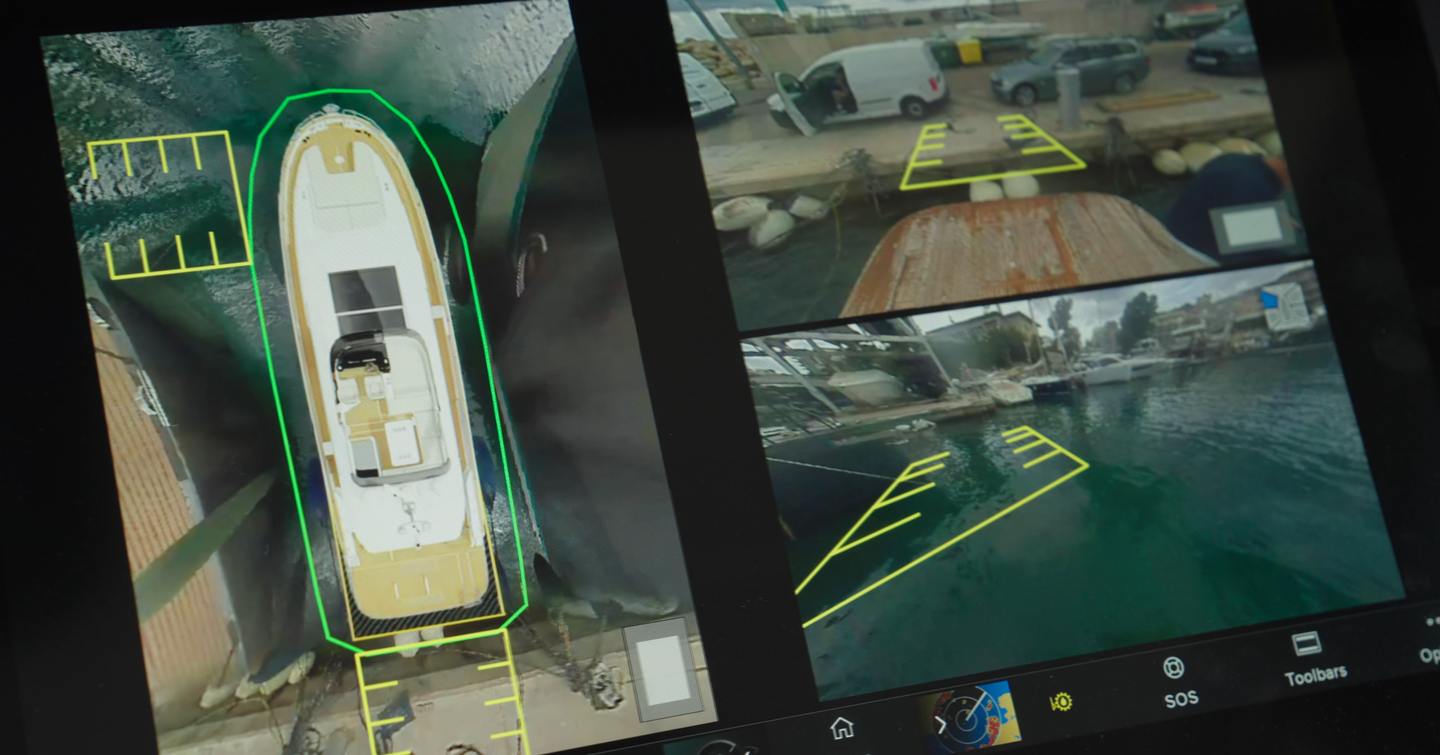

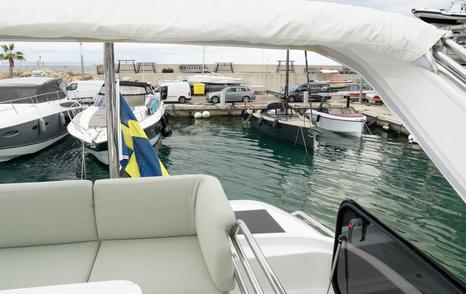
At Sea
Our test boat was hull #1 of the 495 Fly and it’s already seen plenty of time at sea. Nimbus has done thousands of miles of testing, and it shows. Out here, on a calm morning off the Mallorcan coast, the boat feels settled and very secure.
At a cruising speed of around 22 to 25 knots, it sits very comfortably on the water. The ride is soft, it tracks well, and the hull feels secure when you start to lean into a turn. Not a huge amount of heel, which makes sense when you look at what Nimbus has done with the hull shape.
Instead of the usual swept-out IPS pod mounts, the aft sections of the hull are flattened off slightly. The result is a drive setup that’s closer to vertical and that gives a more grounded feel underway with less lean in the corners, more grip, and a bit more classic shaft drive behaviour.
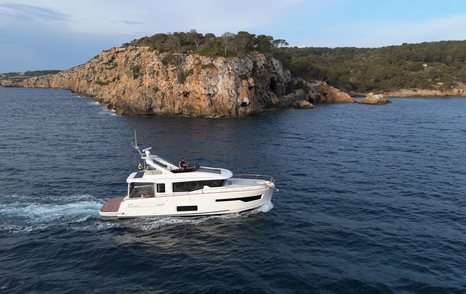
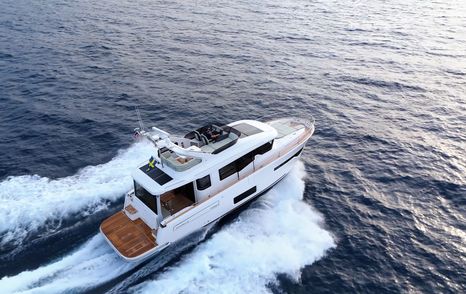
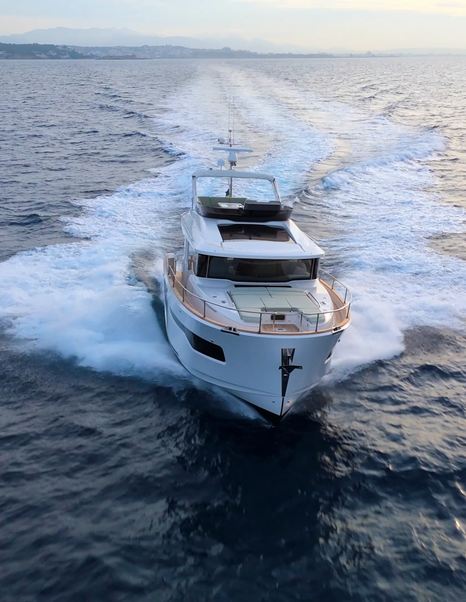
Visibility from the lower helm is excellent. You sit low, almost in a sports car posture, with your legs stretched out and hands falling straight onto the throttle, joystick, and wheel. The multifunction screens are just about within reach, and there’s a control pad on the armrest too, so you’re not constantly stretching forward. At 20 knots, it’s quiet enough to hold a conversation without raising your voice.
Even at wide open throttle - around 28 knots on this boat (future builds are expected to go a touch quicker), the boat doesn’t get flustered. It just picks up speed and keeps going. The flybridge helm mirrors that same relaxed confidence. You sit a little lower up there, but the elevated view is superb and the controls familiar.
There was only a light chop on the day, but the boat shrugged it off. This isn’t a hull that wants to bang or flex. Some IPS boats, like the Sunseeker Superhawk 55, want you to throw them into turns and chase a bit of drama, but with the 495 Fly, you set a course, settle into a 24-knot groove, and you just go along.
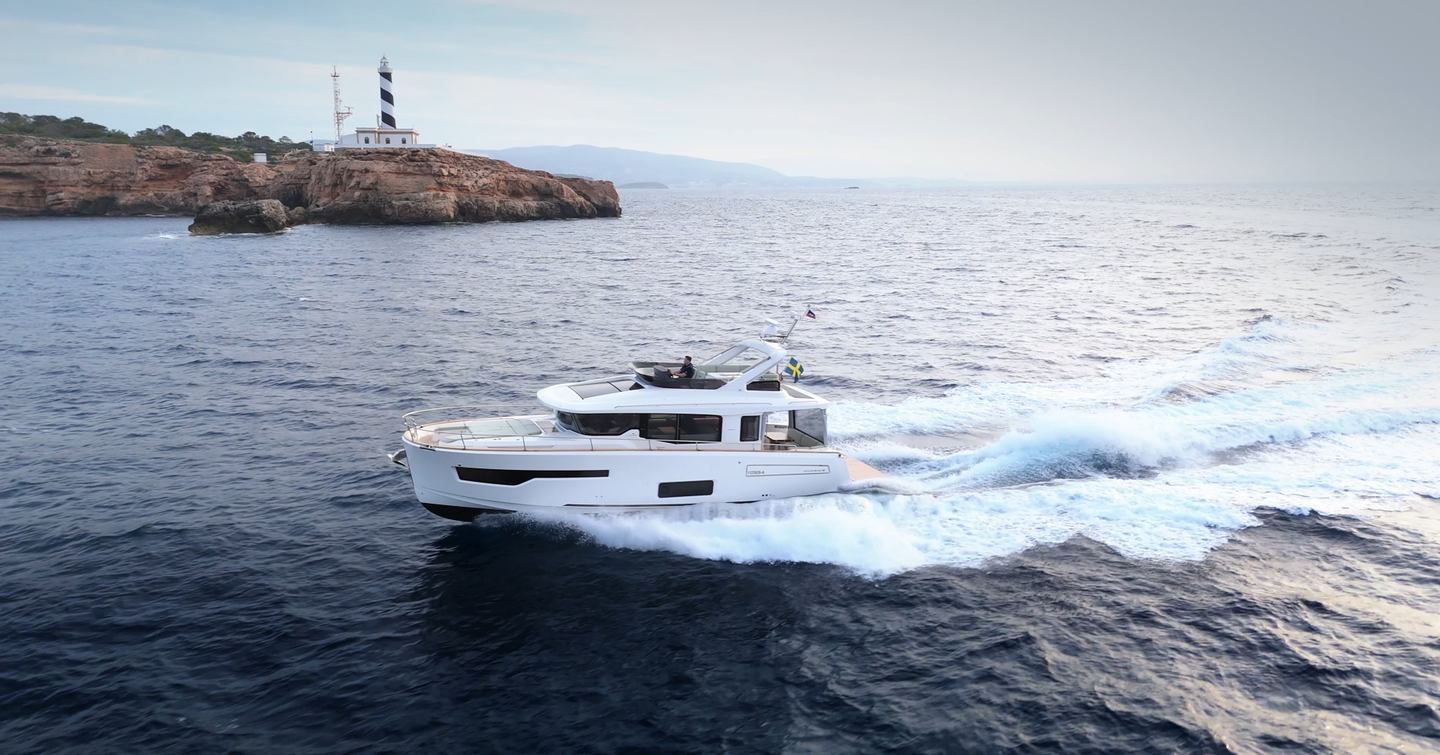
Nimbus had a few goals when designing the 495 Fly. They wanted to break into the explorer segment with a "voyager" boat that would make Nordic coupé designs relevant for a more international market. The aim was to appeal to boaters in the Med and the USA, on top of the Nordics.
Secondly, Joacim Gustavasson, Nimbus' Chief Designer, wanted the 495 Fly to be seen as a “small yacht.” Building upon their earlier coupé models, Nimbus has taken on the challenge of designing and constructing its biggest yacht to date. It's a step up in size and ambition.
Finally, the design brief included making the 495 Fly a floating home that’s comfortable and safe for long periods. Nimbus focused on areas like the saloon and aft deck, integrating safety features, and putting in cosy spots as well as open spaces. There are one or two areas where the designers have traded a bit of ceiling height to preserve the boat’s low profile and centre of gravity, but these compromises are very localised.
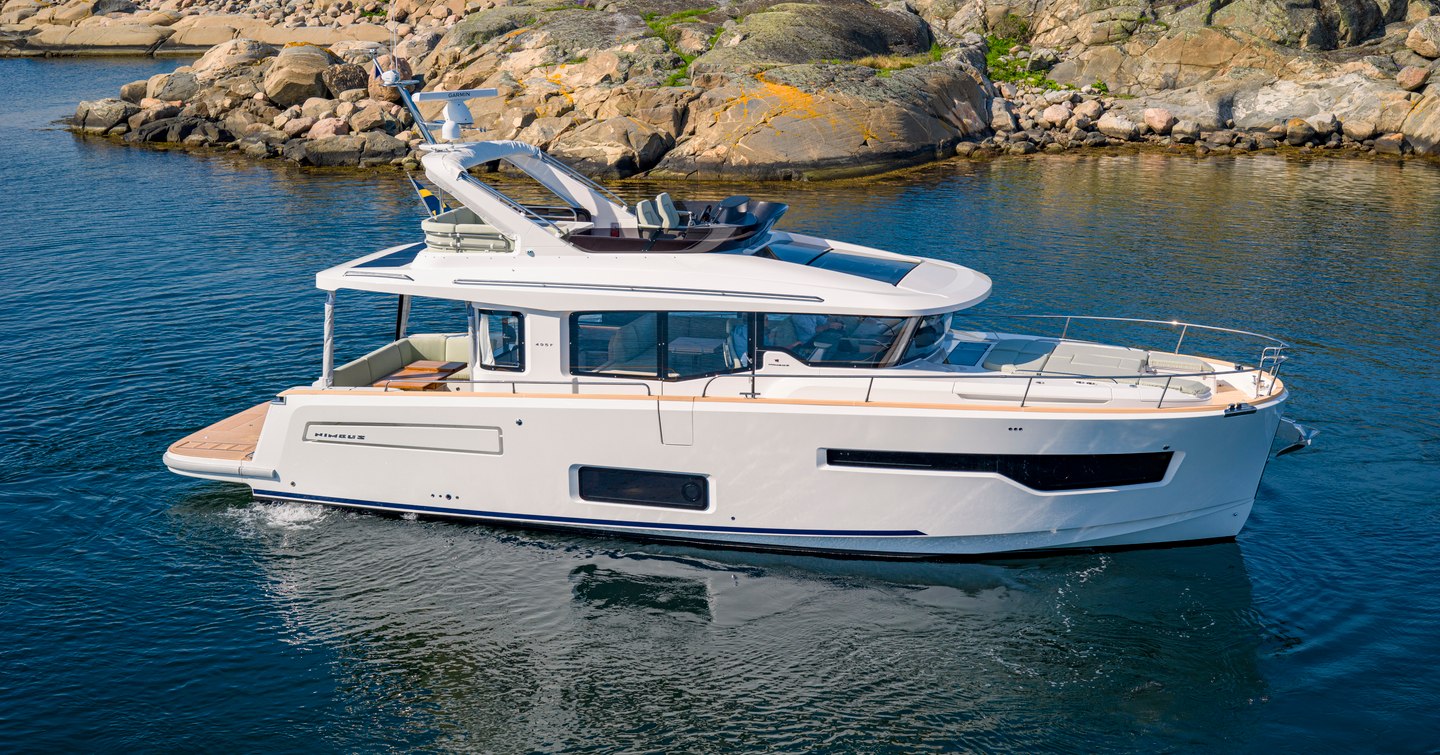
Almost Symmetrical
The asymmetric deck layout is very subtle if you're just looking down at the plans. The starboard side deck is raised up, allowing you to walk comfortably down its length; the port side on the other hand is flush to the main deck and noticeably thinner in person. Mooring gear is nicely hidden in the bulwarks, Ferretti-style, and the fuel fillers are covered on both sides.
One of the most practical features is the positioning of the helm door and boarding gate. They're aligned on the starboard side, so you can step directly from the lower helm onto the pontoon. It’s a small detail, but it makes a big difference when docking short-handed. The only downside is that the sliding door doesn’t hold its position - something as simple as an intermediate latch would make it easier to use in warm weather.
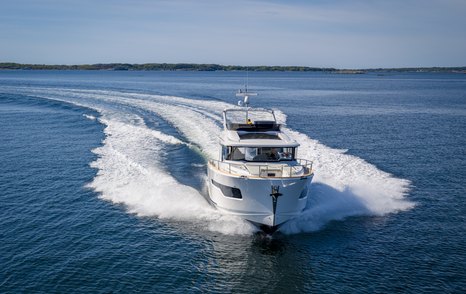


The hull has also been carefully tuned to suit the IPS setup. Nimbus has flattened the aft sections slightly, allowing the pods to be mounted more vertically than usual. That subtle adjustment reduces heel in the turn and gives the boat a slightly more grounded, shaft-drive character, particularly noticeable when cruising at speed.
The aft galley arrangement is designed to connect cooking spaces to the cockpit. You can open up this space to create a bar, making it one big living area when the weather is good. When it's bad, a window and door can close off the area, including a panel of glass that rises up to the ceiling - not something we've seen before in this sector. The glass panel is fully adjustable along its travel and works in tandem with canvas curtain covers on both sides of the cockpit.
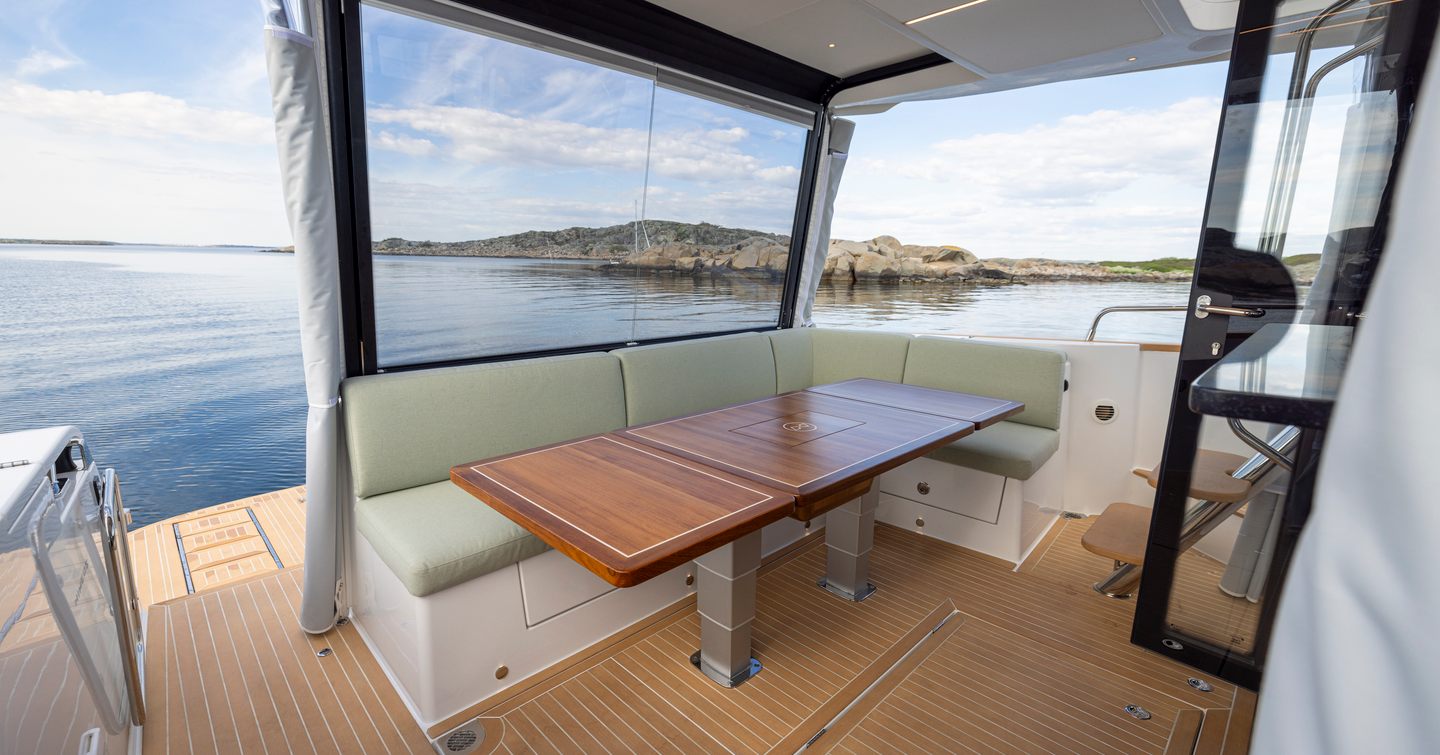
The interior decor is consistent throughout, featuring dark wooden floors, light wood partitions, green sofas, and dark grey walls. If that's not your thing, Nimbus also offers a good level of customisation to reflect the personal style of each owner.
A staircase between the lower helm and forward seating leads down to a lower deck foyer connecting three cabins: the forward VIP cabin with a raised double bed and large side windows, a guest cabin with bunk beds (also usable as an office), and the master cabin.
As for construction, Hull #1 is already proving itself after extensive factory trials. Later builds will benefit from weight savings of around 300kg thanks to refinements in the flybridge lamination.
The galley on the Nimbus 495 Fly is split across both sides of the interior main deck. On one side, you'll find the sink, induction hob/oven, and a large top-loading freezer. The opposite side houses an Isotherm fridge beneath the counter, and a dishwasher - great for a boat of this size, especially if you're cruising with two to four people. It’s all about practicality; for example, there are hooks all over for tea towels and clothing, both up here and below decks.
For example, storage has been maximised through clever drawer design with some extending deep into the counter. There are hooks for tea towels/jackets found throughout the interior and lower deck. One hatch in the galley floor also gives access to a secondary storage space or, if fitted, the optional gyro stabiliser.
There isn't space for a full-height domestic fridge, so cooling is distributed across several areas: the galley drawers, the top loader, and a useful additional chilled compartment beneath the saloon seating. Given the compact footprint of each, having this spread of refrigeration points is a good workaround, especially if you’re onboard for extended periods.
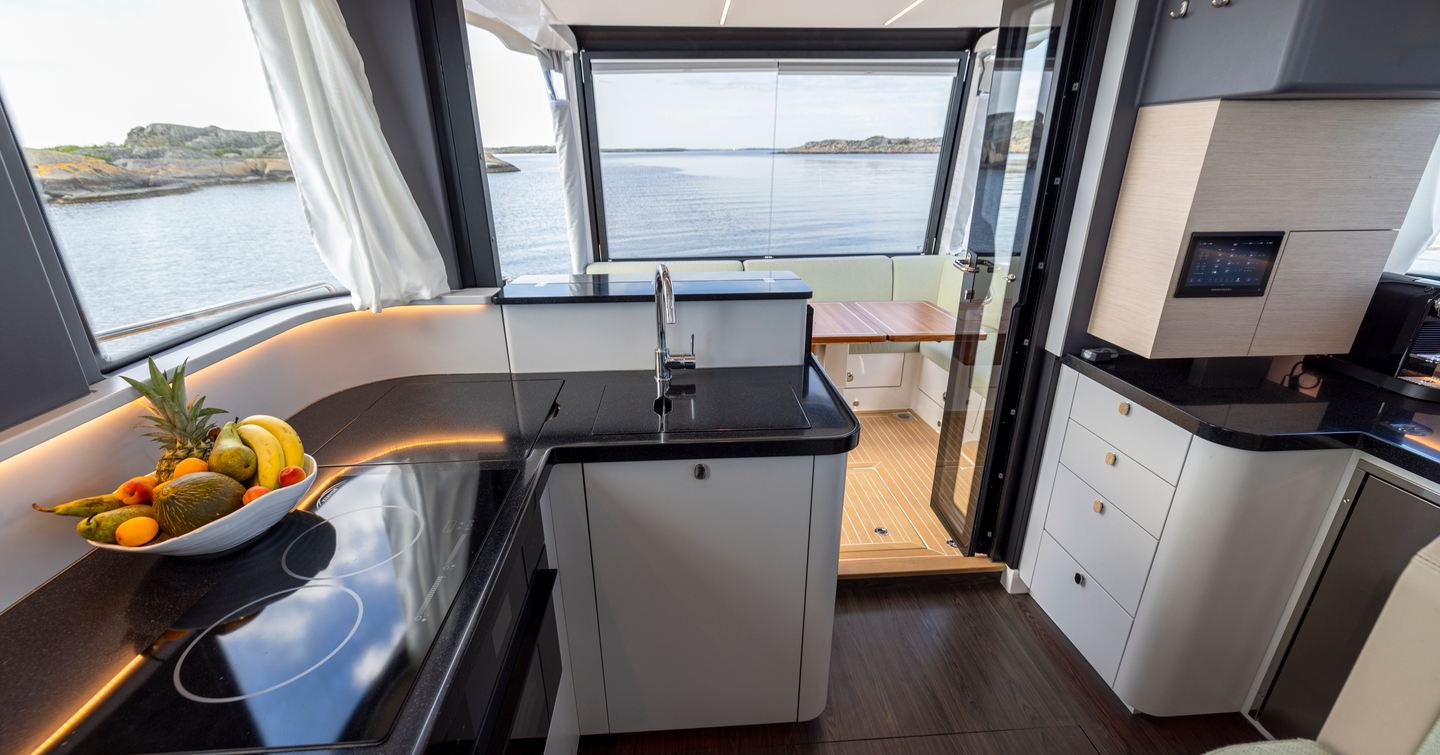
In the saloon, while the flybridge above does lower the ceiling a bit over the seating area, it’s not really a concern when you’re seated and everywhere else the headroom is good. The saloon table is very interesting; it opens up and can twist into various positions, creating an inviting dining space whatever your requirements. Alongside the sliding side door and drop-down window to port, there’s a full-length glass sunroof overhead. Sunroof's are not always a given on a flybridge boat (many brands omit it), but here it adds both light and airflow when you want to crack things open without heading up top. You also get large hull windows, overhead skylights on the lower deck, and opening ports in the bathrooms. To top it off, the TV here pops up and lowers behind a panel.
The sectional sofa is opposite the dining area and part of it can slide towards the table, and the other half has additional cooling storage underneath. Given that the under-counter fridge in the galley isn't enormous, this extra bit of cooling space is welcome.



Owner's Cabin
The owner's cabin on the Nimbus 495 Fly gives more space than you might expect. Positioned amidships, you enter via a little lobby area, leading you straight to the ensuite. The ensuite isn't enormous and the door gobbles up space when it's open, but it does have a separate shower cubicle instead of a wet room.
Once inside the cabin, the headroom is pretty good, though it does drop over the bed area. The bed itself is large and next to it is lots of storage and a seat that can be swapped out for an additional bed. Some owners appreciate having the additional sleeping space as it can sleep a couple of kids if you're boating with family.
The TV is mounted on the wall, and there’s an impressive storage unit on the opposite side, which is where you’ll likely get changed, given the headroom there.
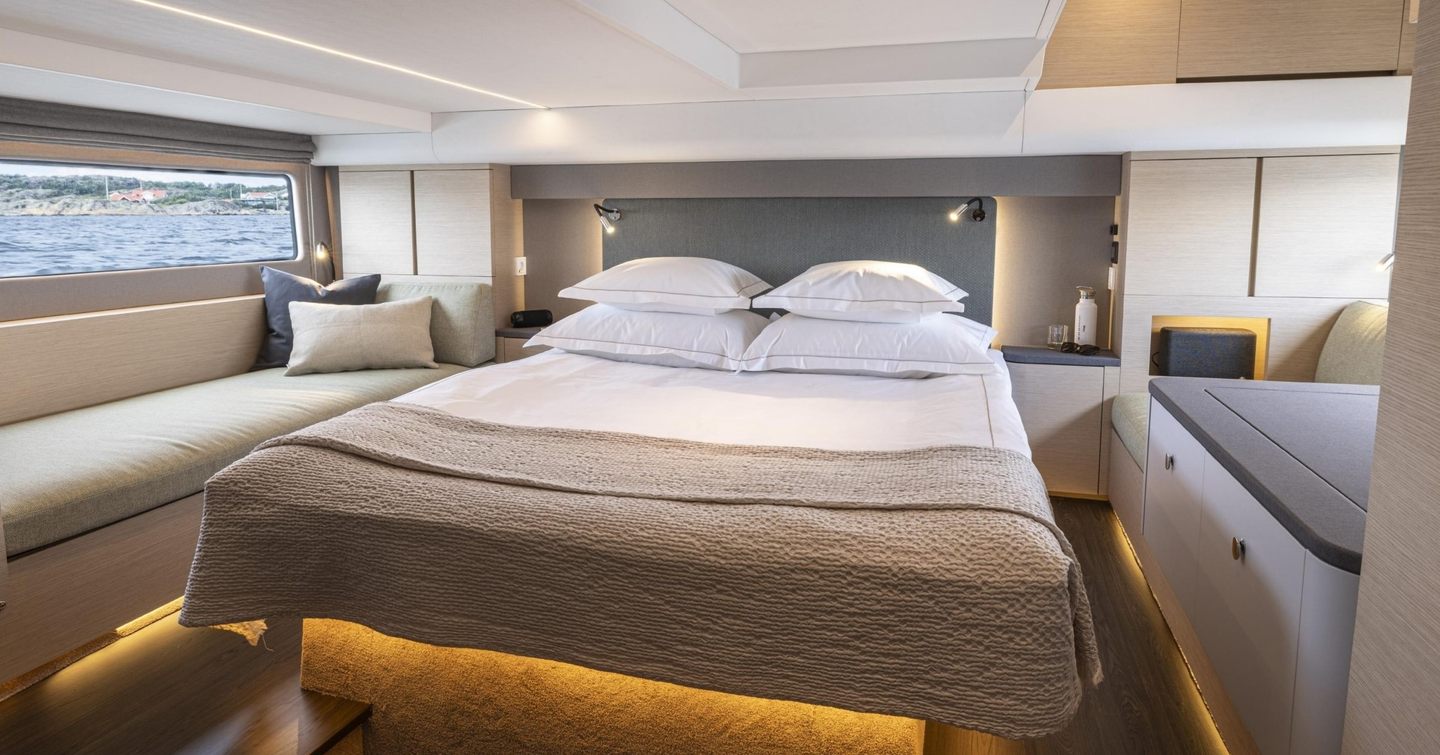
Guest Accommodation
The VIP cabin, located forward, is impressively spacious with excellent headroom. No issues with height restrictions here, making it incredibly comfortable. The cabin is bathed in natural light thanks to the large hull windows on either side and forward-facing hatches, allowing a breeze to flow through beautifully when at anchor.
There are subtle design details here. Both sides feature well-finished, hard-wearing material with lips to prevent items from sliding off and a tilted bed head designed to hide the air conditioning vents.
Although this is the guest suite, it could easily double as the owner’s cabin if you prefer to sleep further away from the machinery.


The twin is surprisingly spacious for a boat of this size. There are bunk beds, which are set quite low, offering a reasonable amount of space above the bunks. There's decent cupboard space, although no hanging space. This cabin can also be specced as an office, though very few owners have taken that option so far. Most would prefer to keep the extra sleeping capacity, particularly for children or extra guests.
There’s a narrow hull window with an opening section, plus climate controls and bedside sockets for device charging. The day head, located opposite, is shared between the bunk cabin and VIP and functions as a guest bathroom.
The helm seat is fully adjustable, featuring armrests and a steering wheel with a joystick for the IPS system. It's very easy to get comfortable and the seated position almost feels automotive. With 480hp per side, the boat can reach a top speed of around 28 knots, potentially hitting 30 knots with a lighter spec. It’s designed to cruise comfortably at 22 to 24 knots, and the joystick simplifies slow-speed manoeuvres.
The steering wheel is surrounded by multifunctional buttons, and there's even a windscreen wiper stalk. That's right, a boat manufacturer has finally found a sensible way to control windscreen wipers. The helm also includes a large sunroof for excellent light and ventilation.



The thrusters and remote controls are conveniently placed right under your arm. The bolster seat can be adjusted, and the armrests can be raised, making it easy to stand and steer when needed. There's a helm door; you can easily get out, use the joystick, and keep an eye on both the bow and stern. From an ergonomic point of view, this helm is one of the best in class.
Storage around the helm is limited though. There are deep cupholders and a few places to drop small items, but nothing for bulkier kit.
The seating area next to the helm is a fantastic spot for a co-pilot. The forward seating features storage compartments on powerful hinges, and there’s a dedicated map light for charting at night.
It's quite unusual for a yacht to have a screen away from the helm, but there's a Volvo Penta screen located by the passenger seat. With two large screens already at the helm, this secondary screen means the passenger can also control the music, view charts, and enjoy the same functionality as the helm screens.
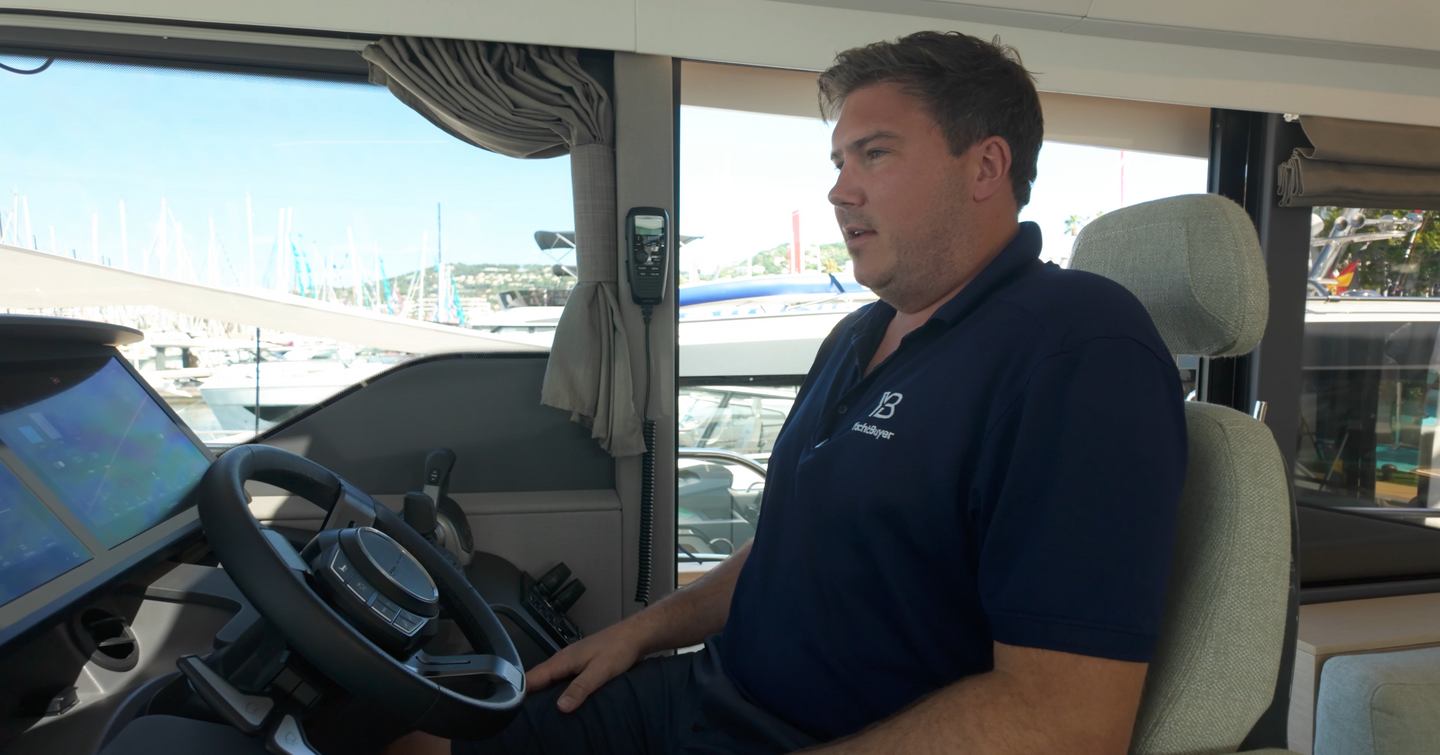
Flybridge Helm
The Nimbus 495 Fly's upper helm station has twin helm seats with a good space between them, meaning you can get in or out of the helm seat without doing a shuffle.
The helm itself is finished in dark materials to eliminate any glare, and there are two MFDs (Multi-Function Displays) that provide all the necessary information, mirroring the setup at the main helm.



When the boat’s pushing along, the upper helm's position is fabulous, offering an unobstructed view and a commanding stance. The seat height is a touch low, however, so you'll need to sit up a bit.
The Nimbus 495 Fly’s bathing platform is a hydraulic mechanism capable of carrying a Williams Minijet 280. The chocks for the tender are set into the platform, and there's also a ladder that extends into the water as the platform lowers. Crafted from eco teak, it does get a bit warm underfoot but there are already plans to change the decking on future models. However, the clever design allows you to walk across the back of the boat even when the platform is down, ensuring ease of movement.
Storage options aft are excellent - really good for stashing ropes and other essentials. There is the option for a wet bar back here which is a brilliant idea for keeping cooking smoke away from the main cockpit.


The platform lowers quickly and reveals a shallow stairway into the water, with steps that deploy automatically as it descends. The benefit of this arrangement is that you still retain a pass-through along the transom, even when the platform is down. Because of the stair design, it’s best to avoid tenders that fully cover the platform - you won’t want to block the steps. Nimbus suggests a 3m (9.8ft) tender or smaller to make best use of the platform.
Wind or Window?
A standout feature of the 495 Fly is its ability to fully enclose the cockpit of the boat. Controlled by the Garmin EmpirBus system, a panel of glass can be stopped anywhere along its travel for a nice ventilated area or brought down for complete closure. Curtain covers on both sides of the cockpit then close for a fully sheltered area and effectively extend the saloon area when the weather isn’t cooperative. It’s an innovative feature; you often see blinds but not a glass panel.
The cockpit has access on only one side, which allows the L-shaped seating to be pushed all the way over, maximising space. The table has a practical design, folding in half when not in use to save space.



Side Decks & Foredeck
For a vessel around 15m (50ft), you'd typically expect narrow sidedecks, but on the 495 Fly it feels more like a walk-around deck, particularly on the starboard side. Plus the 495 has a substantial beam of 4.6m (15ft). The tall, robust guardrails are very welcome, giving a safe space to hang fenders and move around the boat. You could imagine a couple managing this boat on their own because as well as the nice wide side decks, there is also a large helm door, right next to a side door in the gunwale. You can step off the boat straight from the helm in moments. The helm door itself is large and easy to move through, but it doesn’t lock in intermediate positions. A latch or friction stop would be a great upgrade to hold it partially open for ventilation while cruising.
The side deck also features water tanks and drains, concealed under stainless steel plates.
The port side deck is not as spacious as the starboard one, but it's still easy to navigate. There's a continuous rail running towards the back of the boat to help you along.


Pop-up lights on both sides, along with ample storage underneath, make stashing ropes and covers a breeze. The foredeck has a table, sun pad seating area and a forward bow ladder – a trademark of Nordic design – providing easy step-on and off access to islands. This foredeck also includes sunpads with adjustable backrests, allowing you to recline upright or lie flat. Cupholders, handrails, and mounting points for a removable canopy will make it a very inviting place to spend time.
The anchor locker is split-lid, but strangely, the internal space is not partitioned - so anchor chain, lines, and any stowed fenders are all chucked in together and could get tangled.
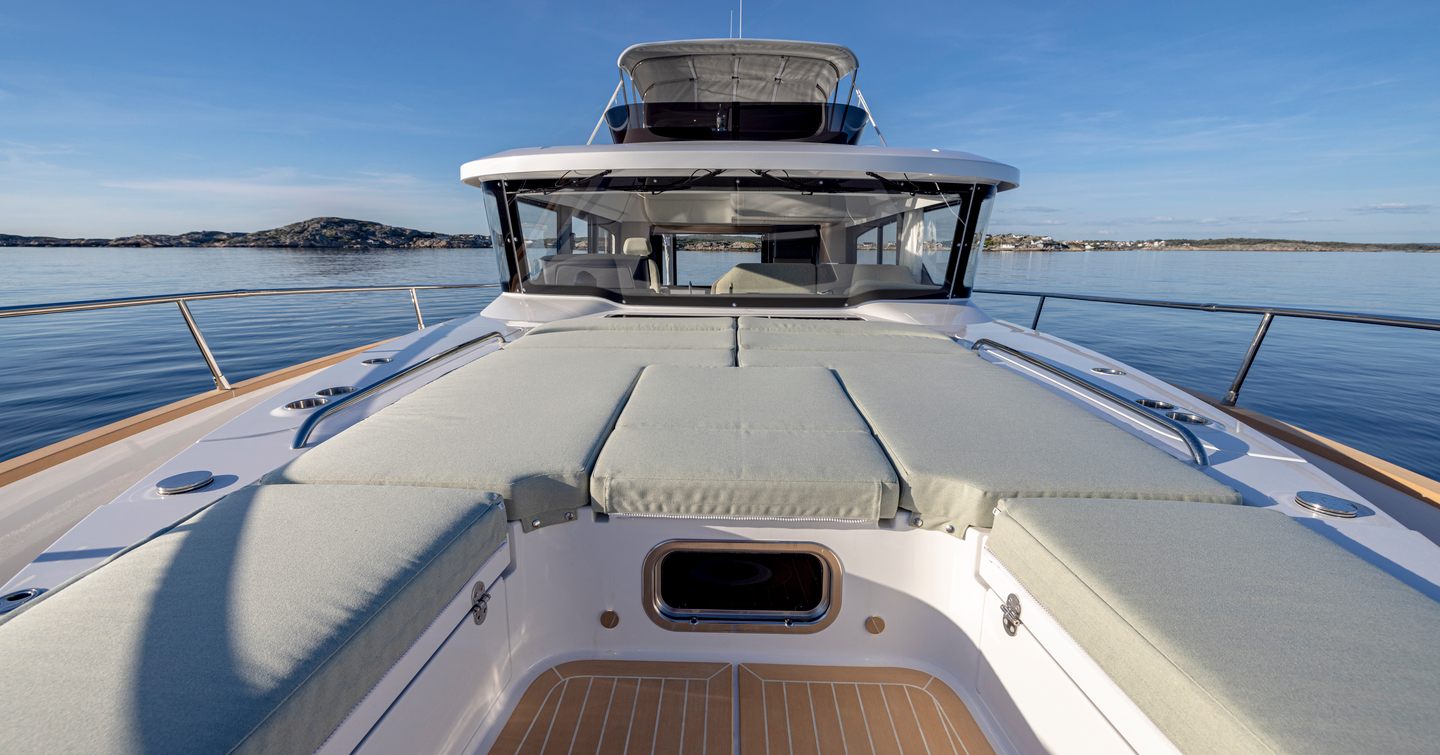
Flybridge
Despite featuring an enormous sunroof above the lower helm, the 495 has a good-sized flybridge. With coverage provided by a Bimini, it’s the only option available, using the old-school-looking radar arches as support, a rare sight these days. This setup allows the Bimini to collapse back onto the radar arch, making it easy to erect and put down when you need some shelter.
The space itself lands somewhere in the middle: more generous than what you’d find on a Botnia Targa 46 or Nordstar 49, but not quite as big as the flybridges on something like the Greenline 45 Fly or Absolute 50 Fly. Nimbus has struck a balance between open-air comfort and keeping the boat’s visual profile low.


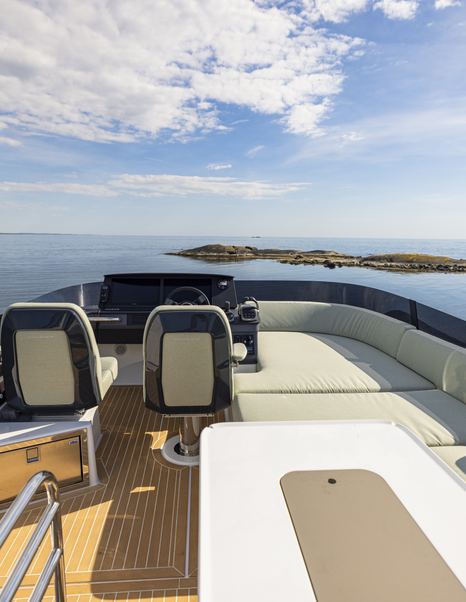
The flybridge includes a big table with a cool trick: lift the table top off, and there's a sink in the middle. Beneath the table, there’s a fridge so you don't have to go downstairs to grab a drink. Moving to the helm station, the sun pad doubles as a seating area for passengers while the boat is underway. There’s no wet bar or grill station up here, which keeps the layout clean but may leave some wishing for a little more independence from the main deck galley.
With the Bimini deployed, the shaded cover is good across the forward seating and helm. The seating area aft of the helm is generous enough for a few guests to stretch out, and the pop-up backrests on the sunpad let you convert lounging space into forward-facing travel seats. Optional solar panels can be fitted on the aft section of the flybridge structure, feeding into the domestic battery bank.
Access to the gyro stabiliser is via a pop-up deck in the galley area but when it comes to engine room access, the Nimbus 495 Fly has a practical solution. There’s a switch that allows the entire hatch to lift up, providing bigger access for more involved tasks. For day-to-day operation, a smaller in-set hatch in this split in the deck lets you pop down to the engine room via a small ladder. This two-tier access works well - use the small hatch for quick inspections and the full hydraulic lift when you need to get hands-on. Just note that on Hull 1, the internal steps must be removed to lift the full deck, though this has been revised on later builds with a hinged step arrangement.
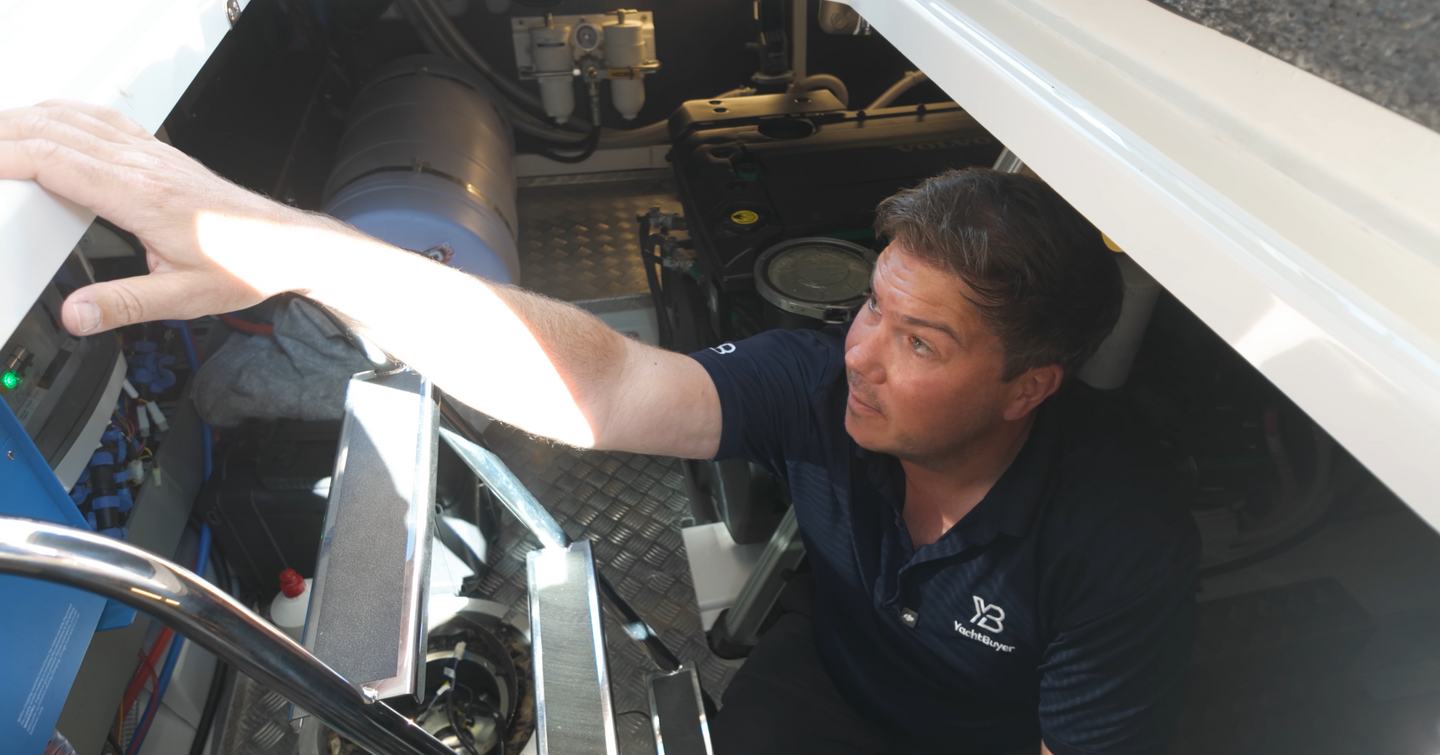
Once inside, the engine room's headroom is a bit restricted but it is to be expected on a boat of this size. Everything is well-organised and tidy, with the generator positioned right aft and the IPS pods and Volvo Penta IPS 650 engines placed on either side, but be prepared to clamber around a bit. While the whole space feels a bit cramped, the ease of day-to-day checks makes it manageable for an owner operating the boat. Remember though, if extensive work is necessary, lifting the entire hatch solves the headroom issue immediately.
The base price for the 495 Fly with the twin 480hp IPS650s (the only engine option) is €1,244,200 ex VAT and that includes a good number of desirable options that would cost extra on other boats, such as Interceptor trim blades, three 12in MFDs, a proportional bow thruster, a lithium-ion battery bank, the sunroof, high comfort mattresses throughout, electric toilets and the retractable aft deck window.
Some cost options worth considering would be the gyro stabiliser (€57,205), the 10.8kw generator (€36,177), air-con (€48,985), the 2x16in glass cockpit MFD upgrade at the helm, radar (€5,793) and Volvo Penta's DPS and Assisted Docking system. The latter is worth it for the piece of mind when berthing as a couple or singlehanded.
With these key extras and a few more in the mix, the boat we toured at Cannes came in at €1,580,000 ex VAT, which is pretty remarkable value for a boat of this size, built to this standard in Sweden.
Our Verdict
The Nimbus 495 Fly proves to be an incredibly clever boat. Having sold a few already, it's no surprise given its appeal.
It’s not the flashiest boat in its class, and the interior design leans more toward the practical, but nearly every detail feels considered. The ergonomics, the access, the systems integration - it all seems to stem from real boating experience. Nimbus has aimed to create a yacht that feels easy to handle, easy to maintain, and usable for long stretches aboard - and in that regard, the 495 Fly is arguably one of the most convincing boats they’ve ever built. One of the best owner-operator yachts in the 15-metre range we've seen so far.
The YachtBuyer Score provides a clear, category-by-category assessment of how the yacht performs in the areas that matter most. In this review, the Nimbus 495 Flybridge receives an overall rating of 4.5 out of 5 stars.
Reasons to Buy
- Outstanding practicality
- Unique glass cockpit enclosure
- Flybridge and a sunroof
- Owner-run potential
- Value for money
Things to Consider
- Eco-teak can get hot
- Some restricted headroom
- Styling is a little plain
Looking to own a Nimbus 495 Flybridge ? Use YachtBuyer’s Market Watch to compare all new and used Nimbus 495 Flybridge Boats for sale worldwide. You can also order a new Nimbus 495 Flybridge , customized to your exact specifications, with options for engine choice and layout configuration. Alternatively, explore our global listings of new and used boats for sale and find your perfect boat today!
Rivals to Consider
Despite the 495 being a flybridge, it is included in the Nimbus Coupé Cruisers range, and they are worth taking a look at when considering a purchase. In production since 2013, the range includes five models with the Nimbus 495 Fly the most recent. This range is versatile, offering three coupes and two flybridges between 10-15m (32-49ft), whether you're into day boating or occasional overnight trips.
Let's take a look at some other rivals. First up, the Jeanneau Leader 46. This yacht boasts an impressive cruising speed of 30 knots, propelled by twin 370hp Volvo Penta D6-370/DP engines, and can reach a top speed of 34 knots. This makes it the fastest in this comparison. If performance is your primary focus, the Jeanneau 46 might be a better bet compared to the more leisurely Nimbus 495 Fly.
Next, consider the Tiara Yachts C49. With a notable cruising speed of 26 knots and a top speed of 31 knots, it’s right up there in terms of performance. But what really sets it apart is its extensive range of 825 nautical miles. Ideal for long voyages, this yacht offers a flexibility that the Nimbus 495 Fly, with its emphasis on stability and comfort, can't quite match.
Moving on to the Sessa Marine C47, which has a shallow draft, making it incredibly versatile for navigating waters that would be off-limits to deeper vessels. Though it doesn’t quite hit the same top speeds as the Jeanneau 46, it brings its own unique appeal. If you're looking for a yacht that can access more secluded spots, the Sessa Marine C47 proves a compelling alternative.
Then there's the Sealine C530, another yacht with a shallow draft. This characteristic makes it appealing for those who want to explore a variety of waterways. It offers a spacious and stylish design but doesn’t quite match the Nimbus 495 Fly in terms of maximum guest capacity. If entertaining larger groups is your priority, the Nimbus might still have the edge.
Considering a new boat? Explore Nimbus' entire current range to find the model that best suits your needs, and compare it with alternatives from competitors to ensure you make the perfect choice.
Specifications
- Builder Nimbus
- Range Coupé Cruisers
- Model 495 Flybridge
- Length Overall 14.9m
- Beam 4.6m
- Draft(full load) 1.2m
- Hull GRP
- Cabins 3
- Berths 6
- Cruising Speed
- Max Speed
- Fuel Capacity 1,700 Litres
- Fresh Water Capacity 520 Litres
- Engine Model 2x Volvo Penta IPS650
Interested in a 495 Flybridge ?
NEW Build
Find your local dealer for a personalised, no-cost consultation
or just request
Brochures & Pricing
Used & In Stock
Looking for a ready-to-go 495 Flybridge or pre-owned options? Explore all inventory of the 495 Flybridge available worldwide
